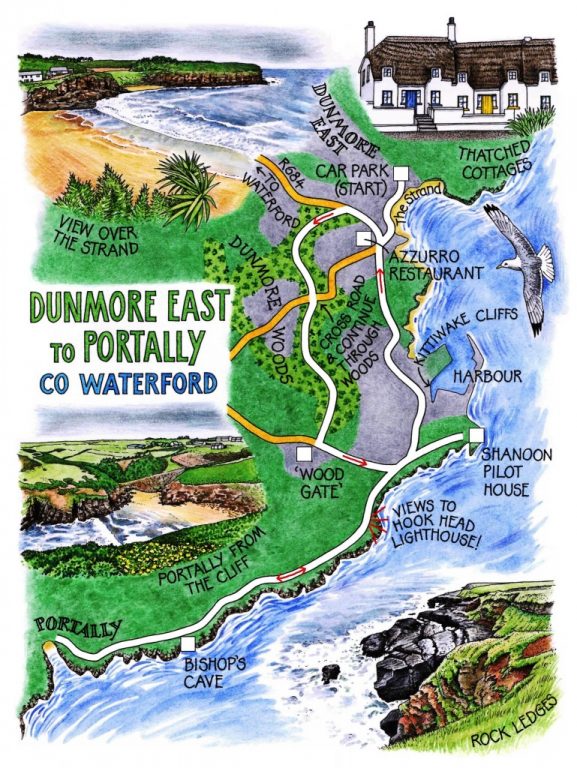 Irish Independent Walk of the Week Christopher Somerville
Irish Independent Walk of the Week Christopher Somerville
19 March 2011
88. Dunmore East to Portally, Co. Waterford
In the 1830s Alexander Nimmo built Dunmore East harbour strong, of local conglomerate sandstone, and he built it sturdy in the face of the south-westerlies that roar into the mouth of Waterford Harbour. These days a few trawlers and creel boats operate out of Nimmo’s fine haven. But it’s mostly holidaymakers who come down to Dunmore East, heading for the picturesque thatched cottages around The Strand’s fingernail of tan-coloured sand. Walkers make their way here, too, arriving in May for a Rambling Festival that makes use of permissive paths all round the blunt peninsula of Dunmore.
Together with Richie Roberts, walk leader and local historian, Jane and I gazed our fill over The Strand from the turn of the cliffs above. Last night, walking back under a three-quarter moon from the Azzurro Restaurant (fabulous hake straight out of the sea, pizzas like mama used to make ‘em), we’d seen the beach rimmed with gentle tides like fine-spun lace. Overnight, though, the wind had sprung up, and today the waves were surging in to hiss up against the dull red cliffs. We turned inland and made for the shelter of the paths that thread Dunmore’s bluebell woods.
At the far side of the village we stepped aside to the tip of Shanoon headland, whose salt-encrusted and weather-battered old pilot house once co-ordinated the supply of river pilots to incoming ships. Below, a clutch of sea-stained trawlers lay at the jetty. A wall of cliffs rose behind the harbour, and a far-off ee-wake! ee-wake! echoed from its ledges.
‘Our kittiwakes are back again,’ Richie observed, pointing them out with pride. ‘Funny – normally they’re a bird that will avoid human working areas, but they’ve chosen that cliff right above the harbour, and that’s where they return every year and nest, no matter what!’
Along the cliffs we followed the coast past beside a gorsy old hedge full of sea pinks. The wider view ahead was of long dark lines of hedgebanks running inland, cutting the coastal fields into thin segments. Out at sea ran the long bird’s-bill promontory of Hook Head, its stumpy Norman lighthouse – the oldest operating light tower in the world – standing isolated above white breaking waves. Shiny black clefts opened at our feet, plunging to thick ledges of rock studded with white nuggets of quartzite. Green seas beat up into their crevices, lazily bursting in long shawls of foam, the backwash even more powerful than the initial wave.
Hollow booming resounded under our boots, as if from the bowels of the ground. ‘The sea in the Bishop’s Cave,’ said Richie. A walled swallet sank deep in the cliff-top field, its seaward end burrowed by sea action into a tunnel. Down there folk would creep in Penal times to hear Mass in the cave, at risk of their lives from soldiers, spies and storms.
Along the sea horizon a giant block of dense dove-grey weather moved east with mighty intent. We could only hope it wasn’t for us. We followed the snaking path round the clefts and headlands, then over a belt of coastal heath – gorse and heather pressed flat and streamed into waves by the sea wind. Suddenly Portally lay below, a slit of a cove burrowed with caves where the sea pounded and sighed. Once upon a time Portally was a more important fishing haven than Dunmore East. But its boats and houses were periodically wrecked by storm waves, their power intensified by the funnelling effects of the narrow cove, and now only a few pot fishermen venture out from here.
Before turning back along the cliffs to Dunmore East, I ran down to the beach. A volley of hoarse barking came from behind a boulder. A tiny, spotted white seal pup lay there, abandoned by its mother to make its own way into the water. It rocked to and fro, barking its warning and fixing me with big round eyes of pure liquid toffee.
Back on the cliff-top we watched as the pup began to waddle seawards. A few metres short of the shallows it stopped, exhausted. ‘Come on! Just one more effort! Come on!’ we urged. The pup gave a final heave, we cheered like fools, and it was in the water and swimming like a good ‘un for the open sea.
WAY TO GO
MAP: OS of Ireland 1:50,000 Discovery 76
GPS: satmap.com
TRAVEL:
Bus (suirway.com) from Waterford
Road: R684 from Waterford
WALK DIRECTIONS: Up shore road from The Strand. Near top, right up steps; cross road (‘Woods Walk’)’ woodland path opposite. At top of climb, left at T-junction of paths. Cross one road, on through woods; at next road, left opposite ‘Wood Gate’ towards sea. On left bend, cross road; right along coast path (‘Coast Walk’) for 1½ miles to Portally. Return along cliffs to Dunmore East.
LENGTH: 5 miles: allow 2 hours
GRADE: Easy
CONDITIONS: Cliff path can be slippy. Unguarded edge – take care!
DON’T MISS … !
• View over The Strand
• Kittiwake cliffs behind Dunmore East harbour
• Portally in its narrow cleft
REFRESHMENTS: Azzurro Restaurant, Dunmore East (051-383141; azzurro.ie) – superb cooking, cheerful ambience.
ACCOMMODATION: Avon Lodge, Dunmore East (051-385775; avonlodgebandb.com) – a welcoming stopover.
DUNMORE EAST RAMBLING WEEKEND: 20-22 May 2011 (tmdharris@gmail.com; dunmorewalks.com)
WALKING in IRELAND: Walking tour operators, local walks including Discover Ireland’s National Loop Walks, walking festivals throughout Ireland: www.discoverireland.ie/walking.
Millstreet Walking Festival, Cork: 9th-10th April – call Derry Sheehan, 086-266-5893
INFORMATION:
Waterford Tourist Office: Waterford Granary, The Quay (051-875788); discoverireland.ie/southeast
csomerville@independent.ie